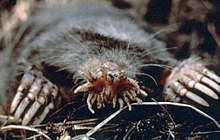Star-nosed mole
| Star-nosed mole | |
|---|---|
 |
|
| Scientific classification | |
| Kingdom: | Animalia |
| Phylum: | Chordata |
| Class: | Mammalia |
| Order: | Eulipotyphla |
| Family: | Talpidae |
| Subfamily: | Scalopinae |
| Tribe: |
Condylurini Gill, 1872, 1875 |
| Genus: |
Condylura Illiger, 1811 |
| Species: | C. cristata |
| Binomial name | |
|
Condylura cristata (Linnaeus, 1758) |
|
 |
|
| Star-nosed mole range | |
The star-nosed mole (Condylura cristata) is a small mole found in wet low areas of eastern Canada and the northeastern United States, with records extending along the Atlantic coast as far as extreme southeastern Georgia. It is the only member of the tribe Condylurini and the genus Condylura.
The star-nosed mole is easily identifiable by the twenty-two pink fleshy appendages ringing its snout which is used as a touch organ with more than 25,000 minute sensory receptors, known as Eimer's organs, with which this hamster-sized mole feels its way around. With the help of its Eimer's organs, it may be perfectly poised to detect seismic wave vibrations.
The star-nosed mole is covered in thick, blackish-brown, water-repellent fur, and has large scaled feet and a long, thick tail, which appears to function as a fat storage reserve for the spring breeding season. Adults are 15 to 20 cm (5.9 to 7.9 in) in length, weigh about 55 grams (2 oz), and have 44 teeth. The mole's most distinctive feature is a circle of 22 mobile, pink, fleshy tentacles (called rays) at the end of its snout, from which it derives its name. These are used to identify food by touch, such as worms, insects and crustaceans.
The extremely sensitive star-like structure is covered with minute touch receptors known as Eimer's organs. The nose is about 1 cm in diameter with roughly 25,000 Eimer's organs distributed on 22 appendages. Eimer's organs were first described in the European mole in 1871 by German zoologist Theodor Eimer. Other mole species also possess Eimer's organs, though they are not as specialized or numerous as in the star-nosed mole. Because the star-nosed mole is functionally blind, the snout was long suspected to be used to detect electrical activity in prey animals, though little, if any, empirical support has been found for this hypothesis. The nasal star and dentition of this species appear to be primarily adapted to exploit extremely small prey. A report in the journal Nature gives this animal the title of fastest-eating mammal, taking as short as 120 milliseconds (average: 227 ms) to identify and consume individual food items. Its brain decides in approximately 8 ms if a prey is edible or not. This speed is at the limit of the speed of neurons.
...
Wikipedia

